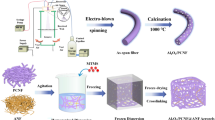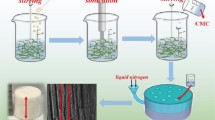Abstract
Monolithic carbon nanofiber aerogels (MCNAs) have aroused much attention for their unique properties. At present, oil pollution has posed great threats to the environment. MCNAs are supposed to be suitable adsorbents for oil adsorption owing to their porous structure, low density and ease of handling. However, facile and inexpensive synthesis of MCNAs still remains a challenge. On this account, low-cost minerals are found to be ideal templates for carbon synthesis. Chrysotile nanofibers with natural fibrous structure were applied as template for MCNAs preparation in this work. Furthermore, calcination at different temperatures was employed to regulate the pore structures and hydrophobicity to enhance oil adsorption capacity. Meanwhile, chrysotile would decompose and form Mg-silicates (MS) under high temperature. MCNAs obtained from this method exhibited a three-dimension cross-linked network structure and good hydrophobicity, leading to high oil adsorption capacity ranged from 25.9 to 29.1 g g−1. Furthermore, the relationship of oil adsorption capacity with mesopore surface area and contact angle was discussed. The work provides not only a novel pathway for low-cost and environmental synthesis of MCNAs, but also a solution for optimizing the performance of oil adsorbents.
Graphical abstract









Similar content being viewed by others
References
**ang G, Chen M, Wang JT, Long DH, Ling LC, Qiao WM, Mochidac I, Yoon S (2016) Fabrication of monolithic carbon nanofiber/carbon composites. RSC Adv 6:6443–6450. https://doi.org/10.1039/c5ra26049c
Liang L, Zhou MH, Li K, Jiang LL (2018) Facile and fast polyaniline-directed synthesis of monolithic carbon cryogels from glucose. Microporous Mesoporous Mater 265:26–34. https://doi.org/10.1016/j.micromeso.2018.01.035
Kim J, Kwon J, Kim S-I et al (2016) One-step synthesis of nano-porous monolithic polyimide aerogel. Microporous Mesoporous Mater 234:35–42. https://doi.org/10.1016/j.micromeso.2016.06.037
Hu X, Zhu J (2019) Tailoring aerogels and related 3D macroporous monoliths for interfacial solar vapor generation. Adv Func Mater 30:1907234. https://doi.org/10.1002/adfm.201907234
Song J, Wang H, Li Z et al (2018) Large-scale blow spinning of carbon microfiber sponge as efficient and recyclable oil sorbent. Chem Eng J 343:638–644. https://doi.org/10.1016/j.cej.2018.02.097
** X, Al-Qatatsheh A, Subhani K, Salim NV (2021) Biomimetic and flexible 3D carbon nanofiber networks with fire-resistant and high oil-sorption capabilities. Chem Eng J 412:128635. https://doi.org/10.1016/j.cej.2021.128635
Kong Y, Zhang S, Gao Y et al (2021) Low-temperature carbonization synthesis of carbon-based super-hydrophobic foam for efficient multi-state oil/water separation. J Hazard Mater 423:127064. https://doi.org/10.1016/j.jhazmat.2021.127064
Wang M, Shao C, Zhou S, Yang J, Xu F (2017) Preparation of carbon aerogels from TEMPO-oxidized cellulose nanofibers for organic solvents absorption. RSC Adv 7:38220–38230. https://doi.org/10.1039/c7ra05506d
Wang YY, Wang XB, Ye HQ, Han K (2019) Carbon coated halloysite nanotubes as efficient sulfur host materials for lithium sulfur batteries. Appl Clay Sci 179:105172. https://doi.org/10.1016/j.clay.2019.105172
Zhong L, Tan A, Yan P, Wang J, Wang Q, Wen X, Cui Y (2019) Palygorskite-template amorphous carbon nanotubes as a superior adsorbent for removal of dyes from aqueous solutions. J Colloid Interface Sci 537:450–457. https://doi.org/10.1016/j.jcis.2018.11.016
SouléMEZ F, Montes MA, ML, Suárez-García F, Torres Sánchez RM, Tascón JMD, (2020) Montmorillonite- hydrothermal carbon nanocomposites: Synthesis, characterization and evaluation of pesticides retention for potential treatment of agricultural wastewater. Colloids Surf, A 586:124192. https://doi.org/10.1016/j.colsurfa.2019.124192
Tong DS, Wu CW, Adebajo MO, ** GC, Yu WH, Ji SF, Zhou CH (2018) Adsorption of methylene blue from aqueous solution onto porous cellulose-derived carbon/montmorillonite nanocomposites. Appl Clay Sci 161:256–264. https://doi.org/10.1016/j.clay.2018.02.017
Tian X, Wang W, Tian N, Zhou C, Yang C, Komarneni S (2016) Cr(VI) reduction and immobilization by novel carbonaceous modified magnetic Fe3O4/halloysite nanohybrid. J Hazard Mater 309:151–156. https://doi.org/10.1016/j.jhazmat.2016.01.081
Ramadass K, Sathish CI, MariaRuban S, Kothandam G, Joseph S, Singh G, Kim S, Cha W, Karakoti A, Belperio T, Yi JB, Vinu A (2020) Carbon nanoflakes and nanotubes from halloysite nanoclays and their superior performance in CO2 capture and energy storage. ACS Appl Mater Interfaces 12:11922–11933. https://doi.org/10.1021/acsami.9b21510
Kim K, Lee T, Kwon Y, Seo Y, Song J, Park JK, Lee H, Park JY, Ihee H, Cho SJ, Ryoo R (2016) Lanthanum-catalysed synthesis of microporous 3D graphene-like carbons in a zeolite template. Nature 535(7610):131–135. https://doi.org/10.1038/nature18284
Bloisea A, Ricchiutib C, Punturob R, Pereira D (2020) Potentially toxic elements (PTEs) associated with asbestos chrysotile, tremolite and actinolite in the Calabria region (Italy). Chem Geol 558:119896. https://doi.org/10.1016/j.chemgeo.2020.119896
Hoskins JA (2018) Chrysotile asbestos cement and the Grenfell Tower fire. Toxicol Appl Pharmacol 361:171. https://doi.org/10.1016/j.taap.2018.04.003
Liu QD, Peng HX, Tian XY, Guo J (2020) Synthesis of chrysotile based nanocomposites for tuning band gap and photocatalytic property. Appl Clay Sci 199:105885. https://doi.org/10.1016/j.clay.2020.105885
Girotto CP, de Campos SD, de Campos EA (2020) Chrysotile asbestos treated with phosphoric acid as an adsorbent for ammonia nitrogen. Heliyon 6:e03397. https://doi.org/10.1016/j.heliyon.2020.e03397
Cao G, Li Q, Wang R, Wang C, Duan X, Ho S-H (2020) Simultaneous separation of multiphase emulsion mixture and catalytic degradation of BPA via microalgae residue membranes. Chem Eng J 393:124750. https://doi.org/10.1016/j.cej.2020.124750
Chen CZ, Li FF, Zhang YR, Wang YM, Wang XL, Sun RC (2018) Compressive, ultralight and fire-resistant lignin-modified graphene aerogels as recyclable absorbents for oil and organic solvents. Chem Eng J 350:173–180. https://doi.org/10.1016/j.cej.2018.05.189
Chao WX, Wang SB, Li YD, Cao GL, Zhao YS, Sun XH, Wang CY, Ho SH (2020) Natural sponge-like wood-derived aerogel for solar-assisted adsorption and recovery of high-viscous crude oil. Chem Eng J 400:125865. https://doi.org/10.1016/j.cej.2020.125865
Zaremba T, Krząkała A, Piotrowski J, Garczorz D (2010) Study on the thermal decomposition of chrysotile asbestos. J Therm Anal Calorim 101:479–485. https://doi.org/10.1007/s10973-010-0819-4
Li Y, Kang Z, Xq Y et al (2018) A three-dimensional reticulate CNT-aerogel for a high mechanical flexibility fiber supercapacitor. Nanoscale 10:9360–9368. https://doi.org/10.1039/c8nr01991f
Wu Y, Huang J, Chen JJ, Li D, Shi XW, Du YM, Deng HB (2021) Ordered hollow nanofiber aerogel with revivability for efficient oil absorption. J Clean Prod 290:125789. https://doi.org/10.1016/j.jclepro.2021.125789
Leitch ME, Li C, Ikkala O, Mauter MS, Lowry GV (2016) Bacterial Nanocellulose Aerogel Membranes: Novel High-Porosity Materials for Membrane Distillation. Environ Sci Technol Lett 3:85–91. https://doi.org/10.1021/acs.estlett.6b00030
Madyan OA, Fan M, Feo L, Hui D (2016) Enhancing mechanical properties of clay aerogel composites: An overview. Compos B Eng 98:314–329. https://doi.org/10.1016/j.compositesb.2016.04.059
Wu XL, Wang YH, Zhong RQ, Li B (2021) Nitrogen and sulfur dual-doped hierarchical porous carbon derived from bacterial cellulose for high performance supercapacitor. Diam Relat Mater 116:108447. https://doi.org/10.1016/j.diamond.2021.108447
Qi LL, Tang X, Wang ZF, Peng XS (2017) Pore characterization of different types of coal from coal and gas outburst disaster sites using low temperature nitrogen adsorption approach. Int J Min Sci Technol 27:371–377. https://doi.org/10.1016/j.ijmst.2017.01.005
Gualtieri AF, Gualtieri ML, Tonelli M (2008) In situ ESEM study of the thermal decomposition of chrysotile asbestos in view of safe recycling of the transformation product. J Hazard Mater 156:260–266. https://doi.org/10.1016/j.jhazmat.2007.12.016
Kusiorowski R, Zaremba T, Piotrowski J, Adamek J (2012) Thermal decomposition of different types of asbestos. J Therm Anal Calorim 109:693–704. https://doi.org/10.1007/s10973-012-2222-9
Mirhadi SM, Forghani A, Tavangarian F (2016) A modified method to synthesize single-phase forsterite nanoparticles at low temperature. Ceram Int 42:7974–7979. https://doi.org/10.1016/j.ceramint.2016.01.195
Hossain SKS, Mathur L, Singh P, Majhi MR (2018) Preparation of forsterite refractory using highly abundant amorphous rice husk silica for thermal insulation. J Asian Ceram Soc 5:82–87. https://doi.org/10.1016/j.jascer.2017.01.001
Wang Y, Jiang X (2016) Synthesis of cell-penetrated nitrogen-doped carbon dots by hydrothermal treatment of eggplant sepals. Sci China Chem 59:836–842. https://doi.org/10.1007/s11426-016-0022-y
Przybylska N, Śliwińska-Bartkowiak M, Kościński M, Rotnicki K, Bartkowiak M, Jurga S (2021) Confined effect of water solution of ciprofloxacin in carbon nanotubes studied by Raman and Fourier Transform Infrared Spectroscopy methods. J Mol Liquids 336: 115938. https://doi.org/10.1016/j.molliq.2021.115938
Subramaniyam CM, Srinivasan NR, Tai Z, Liu HK, Goodenough JB, Dou SX (2017) Self-assembled porous carbon microparticles derived from halloysite clay as a lithium battery anode. J Mater Chem A 5:7345–7354. https://doi.org/10.1039/c7ta00940b
Yang F, Wang G, Ming X et al (2018) Oxygen plasma treated graphene aerogel as a solar absorber for rapid and efficient solar steam generation. Carbon 130:250–256. https://doi.org/10.1016/j.carbon.2017.12.124
Wei ZZ, Gu JY, Ye YX, Fang MQ, Lang JP, Yang D, Pan ZJ (2020) Biodegradable poly(butylene succinate) nanofibrous membrane treated with oxygen plasma for superhydrophilicity. Surf Coat Technol 381:125147. https://doi.org/10.1016/j.surfcoat.2019.125147
Chen X, Liang YN, Tang XZ, Shen W, Hu X (2017) Additive-free poly (vinylidene fluoride) aerogel for oil/water separation and rapid oil absorption. Chem Eng J 308:18–26. https://doi.org/10.1016/j.cej.2016.09.038
Lu Z, Song J, Pan K et al (2019) EcoFlex Sponge with Ultrahigh Oil Absorption Capacity. ACS Appl Mater Interfaces 11:20037–20044. https://doi.org/10.1021/acsami.9b04446
Ahuja D, Dhiman S, Rattan G, Monga S, Singhal S, Kaushik A (2021) Superhydrophobic modification of cellulose sponge fabricated from discarded jute bags for oil water separation. J Environ Chem Eng 9:105063. https://doi.org/10.1016/j.jece.2021.105063
Zhang ZY, Liu H, Qiao WC (2020) Reduced graphene-based superhydrophobic sponges modified by hexadecyltrimethoxysilane for oil adsorption. Colloids Surf A 589:124433. https://doi.org/10.1016/j.colsurfa.2020.124433
Wang FJ, Lei S, Li CQ, Ou JF, Xue MS, Li W (2021) Superhydrophobic Cu mesh combined with a superoleophilic polyurethane sponge for oil spill adsorption and collection. Ind Eng Chem Res 53:7141–7148. https://doi.org/10.1021/ie402584a
Liu ZW, Tang YF, Zhao K, Zhang Q (2019) Superhydrophobic SiO2 micro or nanofibrous membranes with porous surface prepared by freeze electrospinning for oil adsorption. Colloids Surf A 568:356. https://doi.org/10.1016/j.colsurfa.2019.02.038
Chao W, Wang S, Li Y et al (2020) Natural sponge-like wood-derived aerogel for solar-assisted adsorption and recovery of high-viscous crude oil. Chem Eng J 400:125865. https://doi.org/10.1016/j.cej.2020.125865
Songsaeng S, Thamyongkit P, Poompradub S (2019) Natural rubber/reduced-graphene oxide composite materials: Morphological and oil adsorption properties for treatment of oil spills. J Adv Res 20:79–89. https://doi.org/10.1016/j.jare.2019.05.007
Yang K, Ren JQ, Cui YH, Shah T, Zhang QY, Zhang BL (2021) Length controllable tubular carbon nanofibers: Surface adjustment and oil adsorption performances. Colloids Surf, A 615:126272. https://doi.org/10.1016/j.colsurfa.2021.126272
Xu CB, Jiao CL, Yao RH, Lin AJ, Jiao WT (2018) Adsorption and regeneration of expanded graphite modified by CTAB-KBr/H3PO4 for marine oil pollution. Environ Pollut 233:194–200. https://doi.org/10.1016/j.envpol.2017.10.026
Wu G, Ren B (2018) Comparative analysis of correlation coefficient of ATR mid-infrared fingerprint region of automobile oil. J China Crim Police Academy 2:100–103. https://doi.org/10.14060/j.issn.2095-7939.2018.02.019
Acknowledgements
This research did not receive any specific grant from funding agencies in the public, commercial, or not-for-profit sectors.
Author information
Authors and Affiliations
Corresponding author
Ethics declarations
Conflicts of interest
There are no conflicts to declare.
Additional information
Handling Editor: Stephen Eichhorn.
Publisher's Note
Springer Nature remains neutral with regard to jurisdictional claims in published maps and institutional affiliations.
Supplementary Information
Below is the link to the electronic supplementary material.
Rights and permissions
About this article
Cite this article
Qin, B., Li, Y., Kang, H. et al. Tailoring pore structures and hydrophobicity of monolithic carbon nanofiber aerogels for optimized adsorption performance. J Mater Sci 57, 3211–3221 (2022). https://doi.org/10.1007/s10853-021-06810-4
Received:
Accepted:
Published:
Issue Date:
DOI: https://doi.org/10.1007/s10853-021-06810-4




